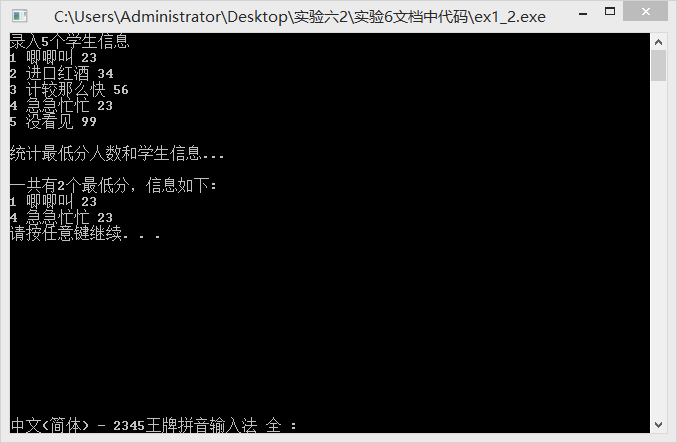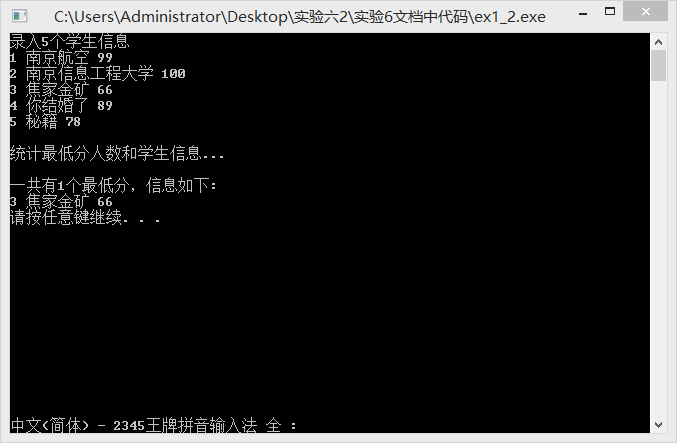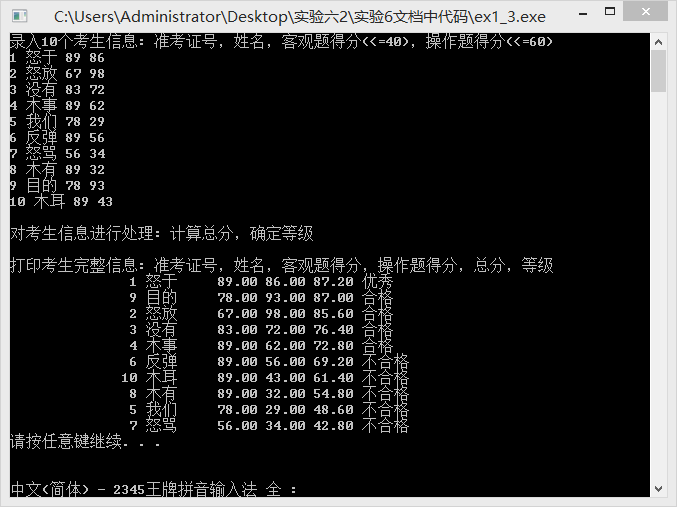实验六
part1
ex1-2
#include <stdio.h> #include <stdlib.h> const int N=5; // 定义结构体类型struct student,并定义STU为其别名 typedef struct student { long no; char name[20]; int score; }STU; // 函数声明 void input(STU s[], int n); int findMinlist(STU s[], STU t[], int n); void output(STU s[], int n); int main() { STU stu[N], minlist[N]; int count; printf("录入%d个学生信息\n", N); input(stu, N); printf("\n统计最低分人数和学生信息...\n"); count = findMinlist(stu, minlist, N); printf("\n一共有%d个最低分,信息如下:\n", count); output(minlist, count); system("pause"); return 0; } // 输入n个学生信息,存放在结构体数组s中 void input(STU s[], int n) { int i; for(i=0; i<n; i++) scanf("%ld %s %d", &s[i].no, s[i].name, &s[i].score); } // 输出结构体s中n个元素信息 void output(STU s[], int n) { int i; for(i=0; i<n; i++) printf("%ld %s %d\n", s[i].no, s[i].name, s[i].score); } // 在结构体数组s中,查找最低分学生的记录,将其存入结构体数组s中 // 形参n是结构体数组s中元素个数 // 函数返回最低分的学生人数 int findMinlist(STU s[], STU t[], int n) { // 补足函数实现 int i,j,count=0;float m; m=s[0].score; for(i=1;i<n;i++){ if(m>s[i].score) { m=s[i].score; } } for(j=0;j<n;j++){ if(s[j].score==m) t[count++]=s[j]; } return count; }


ex1-3
#include <stdio.h> #include <stdlib.h> #include <string.h> const int N = 10; // 定义结构体类型struct student,并定义其别名为STU typedef struct student { long int id; char name[20]; float objective; /*客观题得分*/ float subjective; /*操作题得分*/ float sum; char level[10]; }STU; // 函数声明 void input(STU s[], int n); void output(STU s[], int n); void process(STU s[], int n); int main() { STU stu[N]; printf("录入%d个考生信息: 准考证号,姓名,客观题得分(<=40),操作题得分(<=60)\n", N); input(stu, N); printf("\n对考生信息进行处理: 计算总分,确定等级\n"); process(stu, N); printf("\n打印考生完整信息: 准考证号,姓名,客观题得分,操作题得分,总分,等级\n"); output(stu, N); system("pause"); return 0; } // 录入考生信息:准考证号,姓名,客观题得分,操作题得分 void input(STU s[], int n) { // 补足代码 int i; for(i=0; i<n; i++) { scanf("%ld %s %f %f", &s[i].id, s[i].name, &s[i].objective, &s[i].subjective); } } //输出考生完整信息: 准考证号,姓名,客观题得分,操作题得分,总分,等级 void output(STU s[], int n) { // 补足代码 int i; for(i=0; i<n; i++) { printf("%16ld %-8s %.2f %.2f %.2f %-8s\n", s[i].id, s[i].name, s[i].objective, s[i].subjective, s[i].sum, s[i].level); } } // 对考生信息进行处理:计算总分,排序,确定等级 void process(STU s[], int n) { // 补足代码 int i,j;STU temp; for(i=0;i<n;i++) { s[i].sum=s[i].objective*0.4+s[i].subjective*0.6; } for(i=0;i<n;i++) for(j=0;j<n-1-i;j++) if(s[j].sum<s[j+1].sum) { temp = s[j]; s[j] = s[j+1]; s[j+1] = temp; } for(i=0;i<n;i++) { if((i+1)<=n*0.1) strcpy(s[i].level,"优秀"); else if((i+1)>n*0.1&&(i+1)<=n*0.5) strcpy(s[i].level,"合格"); else strcpy(s[i].level,"不合格"); } }

part2
共用体成员共用一块区域,对一个进行改变就会影响别的成员,不能赋初值
结构体成员有独自的内存区,对其中一个修改不会影响别的成员
part3
枚举类型属于整型
枚举变量不可以直接输入输出
int类型不可以直接赋给枚举,反之可以
心得:
实验实在太难了 ,输出输数据输到心态爆炸。犯了一个小错误找了很久,输出不需要加地址符合都给忘了。还有输入那里的空格老忘记打,也找错误找了很久。



